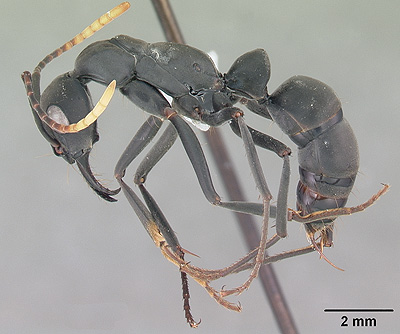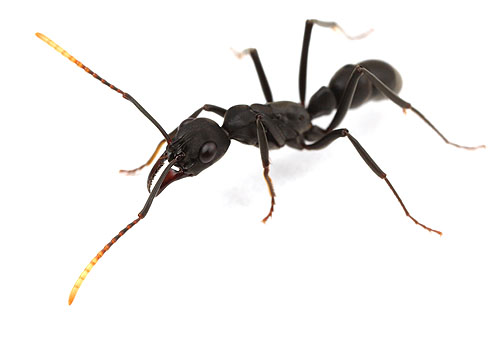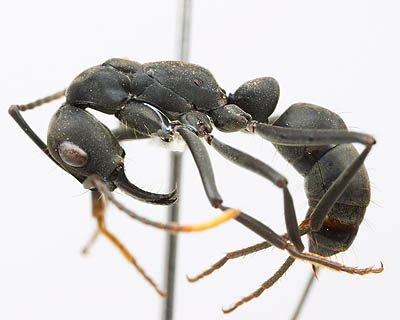A few years ago I needed to image some ants for a short taxonomic paper. Lacking a decent specimen imaging system (like Entovision), I decided to snap the photos at home using my standard macro gear: a dSLR with the Canon MP-E lens. The images turned out fine and were published in Zootaxa with the paper.
Later, the Antweb team imaged the same species using their standard set-up: a high-res video camera on a Leica microscope, focus-stacking the images with specialized software. I decided to compare the two. Here they are (click on each to view the uncompressed file):

Pachycondyla specimen imaged by Antweb using a microscope, video camera, and image stacking software
How do they look? Well, the Antweb image has smoother lighting and a limitless depth of field. Points to Antweb.
But the antweb shot is also a lot smaller. The video camera is tiny compared to the SLR's massive sensor, and a close-up look reveals that the SLR captured considerably more detail. Consider:

enlargement of propodeum, microscope image w/ image stacking

crop of propodeum, Canon MP-E 65mm lens on a dSLR
Score for Canon.
My point isn't to disparage the museum-grade scope/image-stacking systems. Rather, it is that not all specimen imaging situations require them. Image quality is a product of many parameters (lighting, optics, sensor, software etc.) that interact with each other in complex ways. Some imaging situations fall into an area where the cheap SLR gear (well, cheap at $3000) outperforms the $40,000 professional grade museum systems.
In this case I was imaging a relatively large insect, and I had a lens designed to produce a sharp image over an acceptable depth of field for an object of that size. For a small ant, there is no question that the image-stacking system would produce a superior image.
Finally, since I'm not a huge fan of dead bugs on pins, here's a healthy, happy, living Pachycondyla apicalis worker from Panama.

- Log in to post comments



Hmmm. not a huge ant IDer, but the SLR seems to capture greater detail at a particular point, but the scope image seems to have focus (at a lesser detail) over the whole individual? Is this an accurate statement? What I mean is that it looks like the scope captures more characters overall, with somewhat less closeup detail, compared to the camera which has greater detail in some areas but lesser focus in others (e.g. legs, antennae). It seems a set of images would be needed for each specimen.
Another plug for the use of the SLR is that, as you show, it lets you photograph live animals. It's my experience that when you go around looking for ants... they don't quite look the same in the leaf litter as they do on a pin! Live shots help capture things like posture and relative distances a lot better than the standard museum preps.
Alex -- You write "For a small ant, there is no question that the image-stacking system would produce a superior image."
Really? -- I've never been particularly happy with the automontaged images of small ants I've tried to study closely. I think they suffer from the same lack of fine scale resoution as the AntWeb image above. One can't see the fine contours of the cuticle, the pubescence, coarseness of the pilosity, etc.
I'd like to see a comparison like that above illustrated for small ants, too. It would also be of interest to see comparison of ants with different surface textures, e.g. a shiny Solenopsis vs. a similar sized attine, or with different densities of pubescence, e.g. among Paratrechina spp.
As someone who regularly images preserved beetles, I would say that magnification is quite important, but lighting is a significant factor. Museums generally have very specialized lighting while a dSLR needs some tinkering to get similar results.
All in all, I think that, as Alex shows above, that a dSLR does capture good enough detail and that, when paired with image stacking software, the results are equivalent to an museum setup.
Of course you can manually achieve what the 40,000 video microscope system does with a DSLR and some movement stages (and quite a bit of patience) and get the best of both worlds, the resolution of a DSLR and the depth of focus of the microscope stacking system! (But you do require a dead bug, on a pin or not!)
See http://www.laurieknight.net for some examples...
Hey Laurie- thanks for visiting! I've lurked around your site before, you have some lovely shots!